If you ask older Hearthstone players which expansion is their favorite, you would probably hear a few different answers. League of Explorers, Whispers of the Old Gods, Journey to Un’Goro and Knights of the Frozen Throne are probably the most liked sets in the game. However, if you ask about the worst expansion – you will most likely get one of the two answers. According to many polls, Mean Streets of Gadgetzan is considered the most hated expansion – probably because cards such as Patches the Pirate and Jade Idol annoyed a lot of players. On the other hand, when a poll asks for the WORST expansion, as in lowest power level / worst design / etc., the most common answer is always “The Grand Tournament” – at least for people who have played through it.
Of course, with new players starting their Hearthstone journey every day, expansion that launched 3 years ago and can’t even be played in Standard is a distant past, not something they particularly care about. However, some of the older players I know and talk with still think of The Grand Tournament as of something that… just didn’t work. New mechanics fell short, power level of the cards was too low, the meta new cards produced was boring, it didn’t add many new decks or archetypes and so on. But is it really true? Was TGT really the worst expansion in the game, or maybe it had some redeeming qualities? Let’s find out.
Inspire – An Uninspiring Mechanic
Each expansion has its own thing – a new mechanic, card type or something else that makes it stand out. In case of The Grand Tournament, the main “selling point” was the first new keyword since launch – Inspire. It’s a simple mechanic, which activates whenever you press your Hero Power. Something that looked promising turned out to be a rather mediocre mechanic. The biggest issue here was that, unlike Battlecry or Deathrattle, the effect wasn’t “guaranteed” – you still had to do some extra action on top of playing the card to get its effect. You had to add 2 extra mana to the card’s cost, otherwise it was a vanilla-statted (or even worse) minion.
In case of many Inspire cards, Blizzard has simply overestimated their effect’s power. Hero Power is a major tempo loss during most of the game, it only starts being something you can easily weave it in every turn in the late game. Playing a vanilla 3/2 for 2 wasn’t worth it just because it could get +1 Health if you spent 2 extra mana (Boneguard Lieutenant). You couldn’t realistically count on those cards surviving more than one turn, because they were high priority removal targets most of the time.
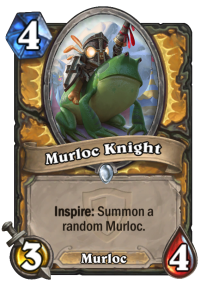
However, out of the 21 Inspire cards, a handful has turned out to be good enough to get into the meta. Cards that either had good enough stats to be played on curve without really losing the tempo with a solid Inspire effects, or those that were actually worth paying 2 extra mana for the Inspire, have seen play in different meta decks. Murloc Knight was used in Midrange Paladin, for example, way before Murloc Paladin was even a thing. It was before cards like Murloc Tinyfin, Sir Finley Mrrgglton or Vilefin Inquisitor were printed, so you had a really high chance to high-roll cards such as Murloc Warleader, Old Murk-Eye or even another Murloc Knight. That kind of Inspire was well worth the 2 mana cost you had to pay for the Hero Power. For just 4 mana (well, 6 if you count the Hero Power) it had potential to snowball entire matches.
Another card that turned out to be nearly meta-defining was Thunder Bluff Valiant, but it took another few sets to see its real power. Shaman was getting more and more synergies each expansion, when thing have finally blown out of proportions in Whispers of the Old Gods / One Night in Karazhan. The meta was called “Shamanstone” for a reason, both Aggro and Midrange Shaman were incredibly popular and powerful. Midrange Shaman in particular had a lot of late game staying power and could swing the game very quickly, and Thunder Bluff Valiant was one of the cards to thank for that. Other than Valiant, cards such as Savage Combatant or Nexus-Champion Saraad have also seen a fair bit of play during their time in Standard.

However, Inspire was the king of another game mode – Arena. While obviously not every single Inspire card was an auto-pick, Arena was generally slower and more “grindy” than Constructed. Hero Power plays a massive role in Arena matches. Not only does it let you hold onto your precious resources, but it can fill those awkward gaps in your curve. Lots of the Inspire cards were very common and strong picks in Arena. Lowly Squire, Kvaldir Raider, Silver Hand Regent, Kodorider or even Mukla's Champion have been too weak to be played in Constructed, but they had really solid snowball potential in Arena and have carried many runs.
No new Inspire cards were printed after The Grand Tournament. While Blizzard goes back to some of their old mechanics from time to time, so far they haven’t decided to do the same thing with Inspire. And I can see why, since it was seen as pretty boring – after all, what’s exciting about pressing Hero Power? I, for one, liked it. It’s definitely not my favorite mechanic, but I would like to see a few more Inspire cards in the future. If given an interesting effect and balanced properly, they can be both fun and exciting to play.
All in all, Inspire wasn’t a huge success, but I wouldn’t say that it was bad after all. Roughly 1/3 of the Inspire cards have seen Constructed play at some point, and some of them were played in the Wild after they have already rotated out of Standard (most notably, Spawn of Shadows was used instead of Prophet Velen as the “combo” finisher in Highlander Priest, before Raza the Chained was nerfed). I really believe that they would balance the mechanic better right now, but it was their first time adding a new keyword to the game – if we think about it that way, they did an okay job.
Joust – Keyword That Wasn’t Keyworded
Inspire wasn’t the only new mechanic unique to The Grand Tournament. “Battlecry: Reveal a minion in each deck. If yours costs more…” was another mechanic, which was featured only in that expansion. Luckily for us, Blizzard has called it “Joust”, it definitely rolls off the tongue much better. It wasn’t keyworded mainly because it’s a pretty complicated mechanic, it had no synergy with other existing cards, as well as they didn’t plan to expand it, at least in the near future (at least that’s the official explanation – my guess was always that they didn’t want to print two new keywords in a single expansion).

Unlike Inspire, which I’ve quite liked, Joust is one of my least favorite mechanics in the game. It adds an unnecessary layer of RNG to each match. You know that silly card game children like to play, called “War”? The one in which each player pulls a card from the top of the stack and the higher card wins? Joust is the Hearthstone’s version of War. It’s bad.
Joust cards suffered from one huge problem – they were really bad if you didn’t win the Joust, and they were overpowered if you did, making a lot of the games rely simply on the Joust RNG. And winning wasn’t easy at all. Keep in mind that drawing (getting a card with the same mana cost as your opponent) didn’t activate the extra effects, since technically you didn’t “win”. And so, unless you specifically built a deck around it, you lost more often than you won.
But, back to the winning vs losing. For example, the most basic Joust card, Gadgetzan Jouster, was a 1 mana 1/2 if you didn’t win and 1 mana 2/3 if you did win. The first one is terrible, and the second one is borderline broken (Zombie Chow was in majority of the decks back then, and it also healed your opponent for 5). Another example – Master Jouster. When it didn’t win, it was worse than a Basic card – Boulderfist Ogre. If it did win, it was a Sunwalker (which was notably an alright card back then) with a +1/+1.
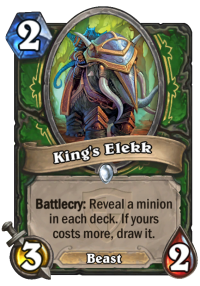
Some of the Joust cards still have seen play, simply because there were no other options, the card were alright even when you lost or they were simply played in a deck built around that. To give you some examples, the Master Jouster I’ve mentioned above was briefly played in Ramp Druid, since it mostly used big minions (and lots of Taunts), so it was relatively easy to win. King's Elekk was played in many Hunter decks, because even if you didn’t win (and you didn’t most of the time in your average deck, to be honest), it was still a 2 mana 3/2 Beast, which wasn’t that bad. On top of that, the card has seen play in Yogg’n’Load Hunter, which played only two other minions besides Elekks – Emperor Thaurissan and Yogg-Saron, Hope's End, making winning the Joust more likely. And finally, Healing Wave has seen a lot of play in slower Shaman decks, simply because they didn’t really have other sources of healing. 7 healing for 3 mana wasn’t amazing, but against Aggro, where healing was more important, you had a higher chance to win (since they had a lower curve), and 14 healing for 3 was amazing when you were getting burned.
It’s probably worth mentioning that Joust has produced one of the worst Legendaries in the history of Hearthstone too – The Skeleton Knight. 6 mana for a 7/4 minion is absolutely terrible. You wouldn’t even want to play that for 5 mana (Salty Dog comes to mind), let alone 6. It’s a terrible tempo play, and while 7 attack sounds good, at 4 health it dies to anything. And when it dies, you either get nothing (and you cry), or if you manage to win Joust… you get it back to your hand. And while “infinite value” is cool, you need to drop a 6 mana 7/4 yet again. I’ve never seen this card used in a competitive deck, even in Arena it was a questionable choice.
While the Joust mechanic was unique to The Grand Tournament, we had one Joust-like card released more recently. Raven Familiar‘s effect is very similar to Joust, the only difference is that it pulls out spells instead of minions. And unlike most of the Joust cards, Familiar is a staple card in currently the strongest Mage archetype – Big Spell Mage.
Staple Cards, Sometimes Expansions Later
It’s true that initially The Grand Tournament didn’t have a massive impact on the meta. In terms of the power level, the expansion felt a bit underwhelming. Yes, we had some immediate staples, but not as much as from… probably any other expansion, actually. However, TGT is one of those expansion that shined later, sometimes much later. It took some cards a year and a half to actually start seeing play. The expansion rotated out in 2017, when Journey to Un’Goro has launched, but before that, it has produced a lot, and I mean A LOT of new archetypes.
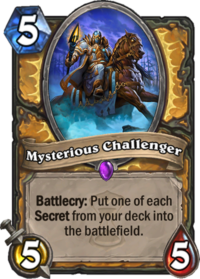
Starting with one of the most infamous decks in the history of Hearthstone – Secret Paladin. It was a dominating meta deck, never really falling out of Tier 1 or high Tier 2 until the 2016 Standard rotation. The entire archetype was similar to Midrange Paladin, but it was activated by a new card from TGT – Mysterious Challenger. It was underrated before the launch, not unlike Corridor Creeper before Kobolds & Catacombs. Most of the players thought that it’s not going to work, after all Paladin Secrets haven’t been working before. Avenge was the only Secret which has seen some play, but in order to make Secret Paladin work you’d need to play many more Secrets – at least 3-4 different ones. However, as it turned out, a 6/6 body for 6 mana (nearly vanilla), which draws and plays 3-5 extra cards was insane. Even if those cards only costed 1 mana and didn’t have a massive impact, they synergized very well with each other and Mysterious Challenger alone was a huge threat. The deck was a pinnacle of “curvestone” – you had insanely strong 1-drop, 2-drop, 3-drop, 4-drop etc. and ideally you just wanted to play each one on the curve without thinking much. Secret Paladin has dominated the meta until most of the on-curve cards that made it so powerful have rotated out (Shielded Minibot, Muster for Battle, Piloted Shredder, Sludge Belcher, Dr. Boom etc.). It also lost Avenge, arguably the strongest Secret in the list. People have tried to revive the deck a few times, but it was never as strong again.
Another notable card from TGT was Aviana. Initially, it was pretty weak. Sure, you could do some combos with Innervate, but they were very hard to pull off and limited by the mana. Four sets later, however, Druid has got another Legendary – Kun the Forgotten King. One of its options was restoring all of the empty mana crystals. And so, playing Aviana + Kun combo means that you had two bodies on the board, 10 mana to work with and your minions have costed 1 mana each. Which made all kinds of combos possible – Malygos, C'Thun etc. While the combo was in Standard for just a few months, it has seen some play. However, it still lives in Wild. For example, lately it’s been a part of a rather popular Mill Druid deck with King Togwaggle – you can get to fatigue, swap the decks and then play Azalina Soulthief in order to copy the Ransom card for when your opponent swaps them back (you just do it again and basically win the game).
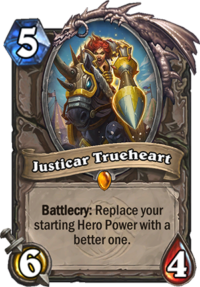
When talking about Neutral Legendaries, Justicar Trueheart is definitely the coolest one. Inspire mechanic was built around Hero Powers, and we had a card that let you upgrade it. While you had to pay 6 mana for a 6/3 minion, for the rest of the game, your Hero Power was stronger. While the card has seen some play in different classes, such as Priest, Paladin or Mage, it was most commonly used in Warrior. It was the pinnacle of Control Warrior – long, grindy games, control mirrors that got deep into fatigue, stacking 50+ Armor. Upgraded Hero Powers still live long after Justicar Trueheart has rotated out through the new Baku the Mooneater.
Another cards worth mentioning are Dragons and Dragon synergies. It’s true that the previous set, Blackrock Mountain, was THE Dragon adventure. However, it was TGT that really popularized Dragon decks by printing some new synergies. Neutral Twilight Guardian was a staple in every single Dragon deck (3/6 Taunt that also activated Dragon synergies – not bad at all), while Chillmaw was a common late game Dragon tech – 3 AoE damage on top of a solid body was a great late game play against board floods. On top of those, Priest has got a Wyrmrest Agent – one of the best 2-drops in the game at the time. 2/4 for 2 with Taunt is still great (Vulgar Homunculus comes to mind), and it was perfect in Priest, a class which easily took advantage of the high health early game minions. Even though Dragon Warrior only got popular later into the Whispers of the Old Gods, TGT’s Alexstrasza's Champion was one of the main reasons why the deck has dominated the meta for weeks. All four of those played an important role in Dragon decks right until the rotation. For example, Dragon Priest has seen a resurgence in Mean Streets of Gadgetzan, mainly thanks to the Drakonid Operative, but Wyrmrest Agent and Twilight Guardian have also played an important role.
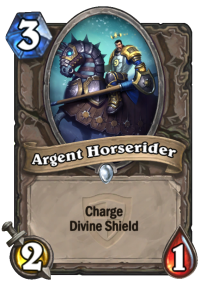
And I could talk about dozens of others TGT cards that impacted the meta heavily. However, to keep things short, I will only name them without discussing them individually. Flame Juggler and Argent Horserider have been a part of Aggro decks for months. Refreshment Vendor was used as a healing option in some decks, but most notably in Reno Warlock. Clockwork Knight was played in Mech Mage, which has seen a bit of a comeback in TGT. Frost Giant was played in an off-meta Giant Warrior combo deck. Nexus-Champion Saraad was played in pretty much every Tempo Mage build from Hotform, as well as some other classes (it was a solid value generator).
Living Roots, Druid of the Saber, Darnassus Aspirant, Mulch and Savage Combatant were played in many different Druid decks, while Astral Communion had an entire archetype created around it. Sure, it was mostly an off-meta deck, but it existed in many different metas and was really interesting to play.
Lock and Load was an important part of the new Hunter archetype, so-called Lock’n’Yogg, created in Whispers of the Old Gods, while Bear Trap, King's Elekk and Ram Wrangler have seen play in many different decks.
Arcane Blast and Polymorph: Boar were used in Tempo Mage builds, while Rhonin has seen some play in different archetypes – even an off-meta builds with Malygos.
Competitive Spirit was a common card in Secret Paladin, Murloc Knight was played in a bunch of different decks, while Seal of Champions, Tuskarr Jouster and even Enter the Coliseum or Eadric the Pure have seen occasional play.
Flash Heal and Holy Champion were common in lots of the Priest builds, and even Confessor Paletress was sometimes used, especially in the early Highlander builds.
Buccaneer and Shady Dealer were played much later, in Pirate Rogue, and Shado-Pan Rider was unexpectedly used in Tempo Rogue builds.
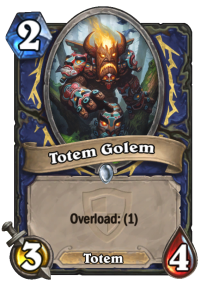
Shaman had a bunch of powerful cards. Starting with the entire Totem shell – Totem Golem, Tuskarr Totemic (it was so strong that it got nerfed later down the road), Draenei Totemcarver and Thunder Bluff Valiant. Ancestral Knowledge was a common option in Aggro build, while Healing Wave and Elemental Destruction were defining cards in slow Shaman builds. Even Charged Hammer has seen some play – the only card that wasn’t played at all was The Mistcaller.
The expansion wasn’t too good for Warlock, with Wrathguard being the only card to be played more (in Zoo Warlock). Fist of Jaraxxus was used in Discard Zoo much later, but not for long, and Dreadsteed created an off-meta archetype around itself.
Warrior has got the infamous Bolster, which never really worked, but other cards such as Bash, Alexstrasza's Champion I’ve already mentioned or Varian Wrynn were used later.
And that’s not everything. Many more cards have seen play in some off-meta builds, there are probably dozens more cards that were tested by streamers in some weird builds. As you can see, that’s A LOT of cards. So was it really all that “bad”?
Closing
When browsing through cards from other expansions, TGT doesn’t seem to be “the worst expansion” at all. Over half of the 132 cards have seen some sort of play, most of those were staple of some build at one point. That’s a good number, considering the fact that expansion had a solid share of fillers. If we listened to the common narrative, we’d hear that most of the cards from expansion were useless, and when you think about it, it’s not true at all. I’d say that the only weak part of the expansion were Legendaries. Lots of the class Legendaries failed, and Neutral ones were pretty mediocre too. There was no “standout” Legendary, which had a massive impact on the meta – no cards like Dr. Boom, N'Zoth, The Corruptor or Patches the Pirate. Most of the Legendaries were just… mediocre, or even straight up bad. At the same time, the card had a massive number of playable commons when compared to some of the other expansions. Which, if you think about it, is good from the budget perspective.
I think that the main issue of TGT was “starting” too many of the archetypes without giving them enough support. Many, many of the cards were later used as a base for an entire deck, but were useless at the moment the expansion launched. So it seemed that TGT cards were bad, while in reality they just needed more support, other synergies and so on. However, the “worst expansion” rating has stuck to it even though its cards were staples in every single meta until the 2017 rotation.
And what do YOU think about The Grand Tournament? Did you like it? What archetypes activated by the expansion did you play? What is, in your opinion, the worst expansion in Hearthstone (in terms of power level, not necessarily card design)? Let me know in the comment section!
Thank you for reading. Good luck on the ladder and until next time!

I dont know which is the worst expansion and i believe no one knows but i know the worst meta. And that was when the frozen throne come out. And that is the matter. The meta and no the expansion as it is. In frozen throne Druids become the most annoyning thing in the game so far.. Was a real nightmare these days. When one of the strong class gets the 2 greater new cards at once. Plague,ultimate….
You must have missed Secret Paladin, Mech Mage and Karazhan Shaman
The worst expansion, hands down, was/is The Witchwood. Anyone who says different hasnt played before The Witchwood.
Also: I liked TGT. In fact I thought the Archetypes out of it were really fun to play. Midrange and Control Paladin, Control Priest and Warrior. Even Hunter had it great times. Nowadays we have Odd Paladin and ….well Odd Paladin I guess.
Just what I thought.
But – as you can see with TGT – there’s hope for better ‘long term value’ when looking at The Witchwood’s card quality. There’s hope at least.
It pains me to know how much i agree with this. We are entering a Brode-less era, and its showing.
Witchwood has the most diverse meta the game has ever seen. The worst meta was Shamanstone in Karazhan.
I think the same. TGT was a funny expansion and I hope in a future remake/similar one. Meta went boring due to pirate warrior and more booooring with cancer decks like highlander priest and jade druid.
“Lock’n’Yogg?” I’ve always called it “Yogg’n’Load.”
“All four of those played an important role in Dragon decks right until the rotation. For example, Dragon Priest has seen a resurgence in Mean Streets of Gadgetzan, ”
You are routinely mixing up your tenses. When you’re talking about the past you should probably use the past.
Repeat in Polish?
Clockwork giant is not from TGT.
And it wasn’t played in Mech Mage… for some reason I wrote “Giant” when I was thinking about “Knight”. Sorry, fixed it.
While I do see your point about TGT overall. I still feel it is valid to consider it the worst expansion. It was not as bad as everyone made it out to be, but it ultimately was not a great expansion. There were problems with some card designs and while there were cards from the expansion like aviana that allowed some combos and saw a lot of play. It was ultimately, in my view, an unhealthy combo for the game. While there are many cards from tgt that saw play in the game and popularity they were not healthy for the game. Totem golem and tuskarr totemic were not healthy cards to exist in the game at its state then. A new expansion should change things in the immediacy while having a good shelf life/potential in the future. Witchwood did that. While many dislike it. It definitely changed the game in an immediate sense and has plenty of cards that I see much future potential with. Just the even and odd does that.
The Ground Tournament is best known for two things.
1. Mysterious Challenger
2. And the bad Legends
I joined in June of 2015… so this was my first Hearthstone expansion experience. I’ll never forget the hype around cards like Varian, Eydis, Rhonin, Mistcaller…. and boy did they flop. Varian Wrynn turned out to be the biggest FLOP in HS history – and still is, and by a good margin. A lot of people were freaking out over that card and it turned out to be terrible.
There is no way Varian is the biggest flop in HS history, it was certainly overrated, but it saw play in meta decks that made it to T1 (had a friend reach #1 legend with Varian in a Dragon Warrior). Almost every shaman legendary ever printed was worse than Varian.
As far as the article goes, the argument for TGT not being the worst expansion isn’t made at all, you can’t just say ‘it wasn’t that bad’, you have to offer an alternative worst expansion. Even if it ‘wasn’t that bad’ it may well still be the worst expansion (it definitely was) in terms of design/power. Gadgetzahn had a lot of good ideas going into it, it was thematically strong and there was a lot to experiment with, in the end the problem was that Blizzard introduced a bunch of cards that were extremely unbalanced and broke the game. To make matters worse, they didn’t address the balance issues with “patches” for an excessive amount of time, hence ‘most hated’ but still not worst
Good analysis. As with much of Hearthstone, the opinions of the masses rarely stand up to good data. Also, this is kind of in line with your articles on psychological traps we fall into. This is the “halo and horn” issue (a good thing or bad thing coloring the overall view inappropriately), as well as “primacy and recency” (the only thing we remember is our first impression, or most recent impression). TGT seemed lackluster upon its release, so forever more, it sucked.
I started and quit during beta, and came back to play consistently when Old Gods released. I remember everyone badmouthing TGT “don’t buy those packs. that set sucked!” and such. To your point, it was a great set for commons that you needed, so I just crafted those for the most part… but their loss really changed the meta. There is something to be said for a set that has solid, playable cards you can craft for cheap rather than having to chase all the Legendaries.
Great article. Thank you for taking the time to point out so many of the decks where different cards were used. I’ve played through each expansion, but to be frank as much as I disliked The Grand Tournament for the low power level it added to the game and what weak cards it brought and it being the worst, I somewhat feel the same way about the witchwood. The Witchwood hasn’t been a very fun meta environment (for me) in standard. Many of the high impact cards are niche, the difference is clear from what they learned from then and now and how they can still at least form a power level of what they want a standard to look like by including cards like Baku and Genn, but quite frankly it’s not had quite as much experimentation longterm so far and I hope that other expansions going forward can flesh it out further to make use of more cards. Seeing as it’s the first expansion that will be in rotation for two years im thinking it certainly will, but it’s still not been quite as enjoyable or exiting. It’s has the same bland feeling as TGT that I haven’t experienced since TGT.
Hi, Great article!! i stopped playing when Blackrock came out, and only came back last year a couple of weeks before Catacombs, so this was a nice read about a period i missed.
There is one thing you said tho that i think is incorrect “inspire…was the first new keyword since launch…” Maybe i’m wrong but, wasn’t “Deathrattle” the first introduced keyword after launch? i remember it came out along with the first adventure (Curse of Naxxramas).
Deathrattle was in the game from the beginning – see Loot Hoarder, Harvest Golem, Sylvanas, etc. It was emphasized as a theme in Naxxramas but was already a big part of the game.
OK, thx, my bad
I love TGT, most of the stuff at least, like the “knighthood” flavor, and both mechanics, even though they turned out to be failed through insufficient support or poor balance. Inspire would put a highlight on your hero as opposed to your minions and I think that’s really cool. Joust would reward you for playing patiently with big minions, which I love doing.
It’s a pity Blizzard has a policy of “never buff, rarely nerf” or we could hope to see more of those cool cards in play. And I think it’s lame that most of the time a new expansion is announced, haters everywhere start saying how weak it is… Witchwood might be the best example of how that can turn out to be wrong.
Well in my opinion and many people mean streat gad is the worst
There are two kinds of “worst” – TGT is “worst” as in the “weakest” or “least impactful”. MSOG is “worst” as in the “least enjoyable one”. At least according to polls.
Calling MSOG “worst”, as in “weakest”, would be a pretty bold statement